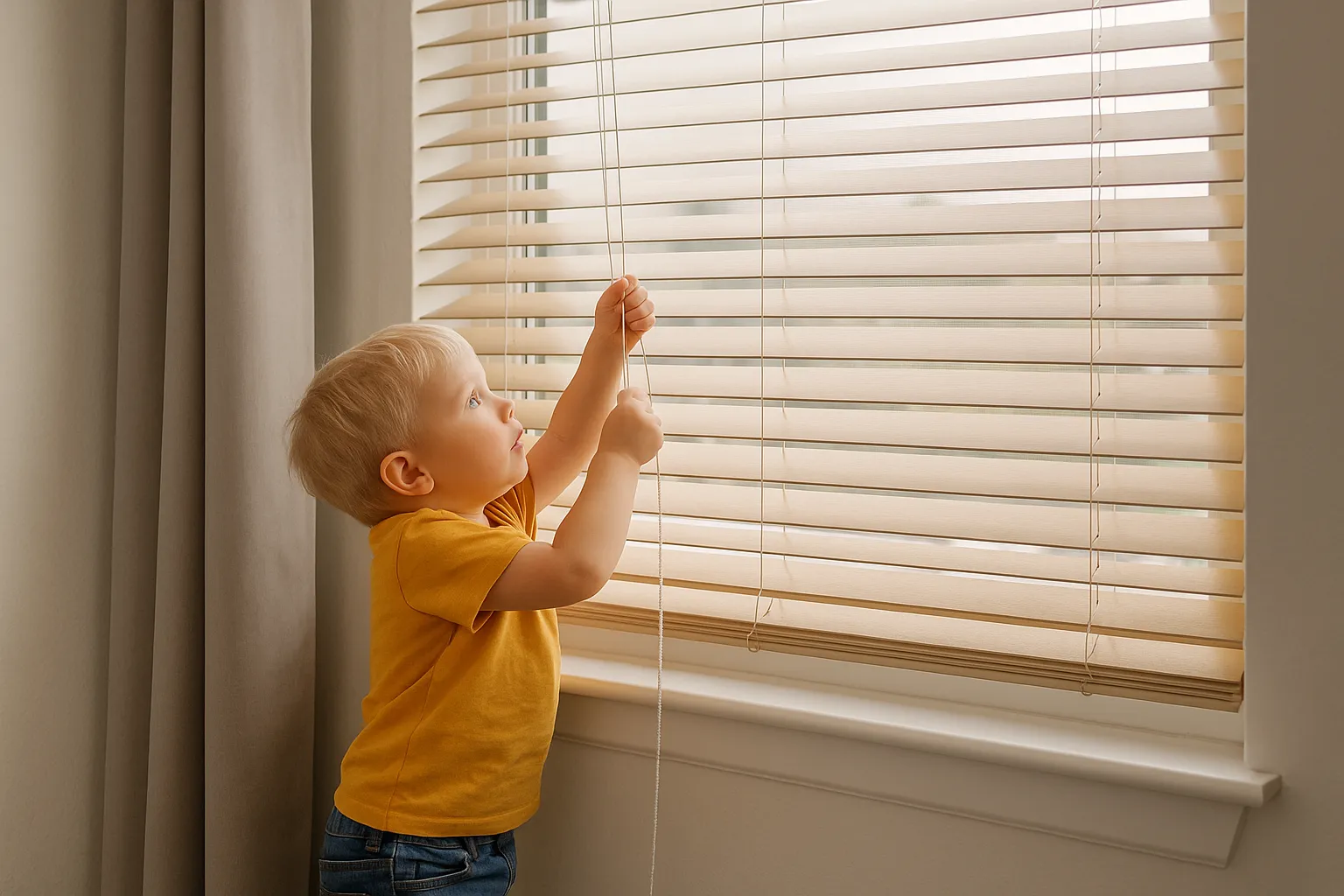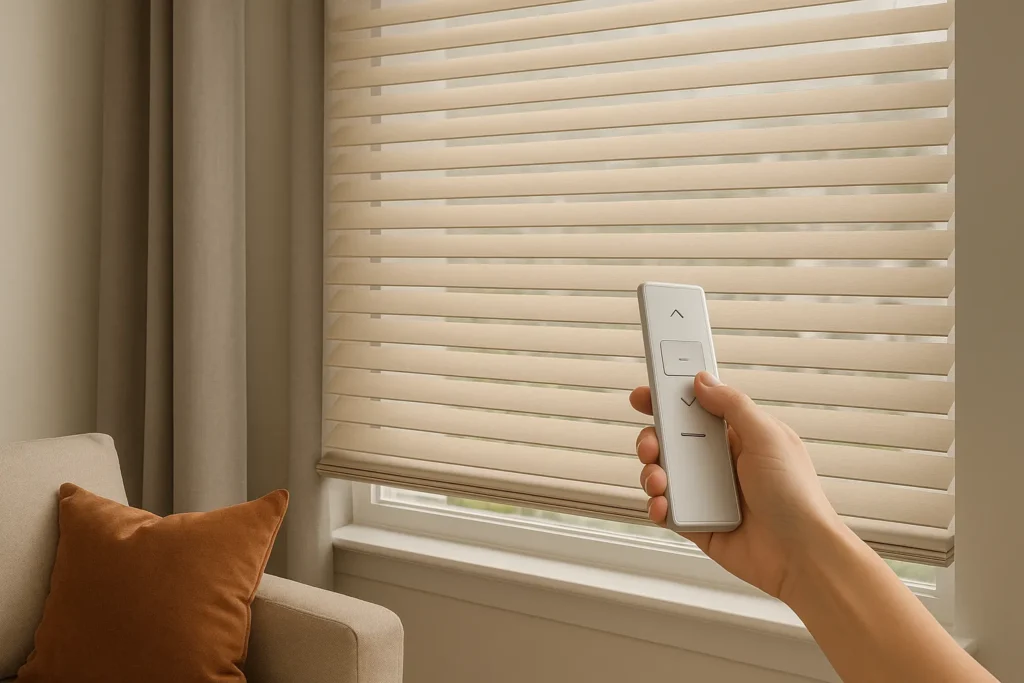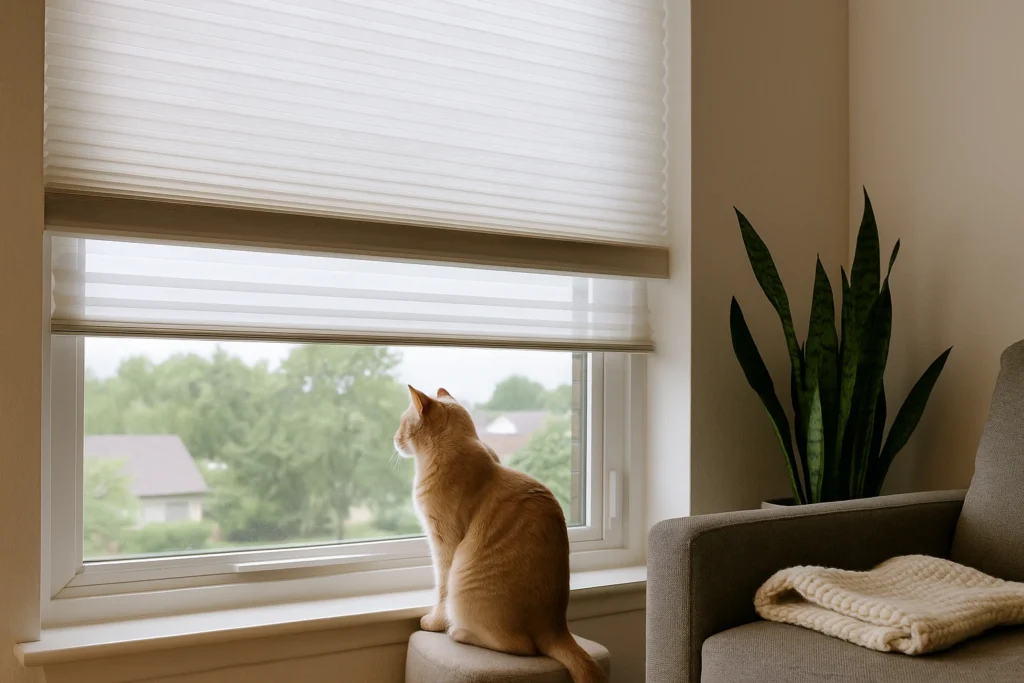
You’ve baby-proofed the stairs, tucked away cleaning products, added outlet covers, and secured furniture to the walls. Your home feels like a safe place, a sanctuary for your kids and pets. But there’s one commonly overlooked danger that often goes unnoticed: window blind cords.
To a curious toddler or an energetic cat, those dangling cords look like toys. But in reality, they are a threat to children. Entanglement accidents happen more often than many realise, and they happen fast. What looks like a harmless loop can quickly turn into a serious hazard.
Over the next few minutes, you’ll learn exactly how to reduce these risks while keeping the comfort, convenience, and style you enjoy.
We’ll begin by taking a closer look at what makes traditional blinds so dangerous.
Why Traditional Blinds Can Be Harmful
Window blinds are common in households, but if they have cords, they can create serious safety hazards for children and pets. For families with children or pets, knowing what to look out for is the first step toward making smarter, safer choices.
Looped cords
Why are looped cords dangerous? Because they can tighten quickly around a child’s neck or limbs, often without warning. This can lead to strangulation in a matter of seconds, especially when the child is left unattended, even briefly.
According to the U.S. Consumer Product Safety Commission (CPSC), an average of nine children under five years of age die each year from strangling due to window blinds, shades, draperies, and other window coverings with cords.
These tragedies can occur in seconds, even under adult supervision.
Pets and play
Pets, especially cats and small dogs, are naturally curious and may play with hanging cords. To them, a cord is a toy to swat or chew.
Unfortunately, this innocent play can quickly result in life-threatening injury. A startled pet can panic if caught, turning a minor incident into something far more serious.
Outdated standards
Homes with older blinds are especially at risk. Many blinds installed before 2018 do not meet today’s safety standards.
In response to recurring accidents, a revised standard was introduced requiring that all stock blinds sold in retail and online settings be cordless or feature short or inaccessible cords.
Yet, countless homes still rely on outdated and non-compliant coverings.
Tension and frustration
Even beyond safety, corded blinds can be frustrating to use. They frequently get tangled or caught on nearby furniture. This can make everyday tasks like adjusting natural light more cumbersome and cause long-term wear or breakage.
Understanding these risks is the first step toward a safer home. Fortunately, today’s window treatment options make it easy to avoid these dangers.
Safety Without Sacrificing Style: Cordless and Motorised Options

Why settle for style or safety when you can have both? Today’s cordless and motorised blinds offer both modern function and peace of mind.
Let’s briefly take a look at why they’re good options:
Cordless Blinds
Cordless blinds eliminate the need for hanging cords completely. Instead of pulling on strings, you simply lift or lower the bottom rail to adjust the shade.
It’s easy to use and looks clean and tidy. This kind of design is especially helpful in busy spaces like kitchens, living rooms, or nurseries, where safety matters most and clutter is a distraction.
According to the U.S. Consumer Product Safety Commission (CPSC), cordless blinds are the recommended choice for homes with children or pets. They remove the main risk: strangulation and entanglement hazards from loose cords.
Motorized Blinds
If you’re looking for even more convenience, motorised blinds are a great step up. You can control them with a remote, a smartphone app, or through your smart home system.
Some families love using voice commands with assistants like Alexa or Google Home, especially when hands are full or when managing hard-to-reach windows.
Motorised options are also programmable. You can schedule them to open in the morning and close at night, helping to manage indoor temperatures and protect privacy without lifting a finger.
There’s no shortage of style when it comes to cordless and motorised blinds. You can choose from a variety of colours, textures, and materials, from an eye-catching timber look to a minimalistic fabric finish. It’s a smart upgrade that includes both safety and beauty for your home.
But what if you’re not ready to replace everything? No problem. You can still make your current blinds safer.
How to Make Your Existing Window Coverings Safer on a Budget
Replacing all your window coverings isn’t always practical or affordable for everyone. But there are easy, affordable ways to make the blinds you already have much safer.
With just a few upgrades, you can reduce the risks and buy time before committing to a full home makeover. Let’s see how.
Secure Loose Cords with Cord Cleats
Cord cleats are small, inexpensive fixtures that let you wrap excess blind cord neatly and out of reach. Install them high up on the wall next to the window, well above a child’s reach or a jumping pet’s height.
They work best for horizontal blinds and Roman shades. You can find cleats in most hardware stores, and they usually come with adhesive or screw-in options.
Add Chain Loop Tensioners or Cleat Kits
Chain loops on roller or vertical blinds can become dangerous if left loose. A tensioner or cleat kit keeps the chain tight against the wall, reducing the risk of entanglement. Some kits include breakaway clips that release under pressure.
This small safety upgrade takes minutes to install but offers lasting peace of mind for any home with kids or pets.
Upgrade to Beaded Metal Cords
If your blinds use fragile plastic chains, consider switching them out for beaded metal cords. These are stronger, easier to spot, and less likely to break or create invisible loops.
The added visibility helps deter children from playing with them, and they stand up better to wear and tear, especially in homes with active pets.
Remove Blinds from High-Risk Zones
Some spots in your home may not be ideal for any kind of blind, especially if they’re frequently used by kids or pets. In nurseries, swap out blinds for soft curtains or blackout film applied directly to the glass.
For pets that love to sit on windowsills, remove blinds entirely or install cordless alternatives high up and out of reach.
Tip: During your next weekly clean-up, take a few minutes to check each room. Look for loose cords, wobbly fittings, or blinds that might be within a child’s reach. Simple fixes like securing a cord or moving furniture can make your home much safer without much effort.
But different window coverings come with different benefits, and pet owners have some added challenges. So, let’s find out which blinds are best for homes with pets.
Best Window Treatments for Homes with Pets

If you live with a curious cat or a window-watching dog, you know how quickly blinds can take a beating. Some scratch, some chew, and others just get tangled in the mess. The good news is, there are window treatments that can handle the chaos and still look great.
Below are some options to keep your windows both safe and stylish.
Use Top-Down, Bottom-Up Shades
These shades are perfect for homes with curious pets. You can lower them from the top, keeping the bottom closed.
This setup lets in plenty of natural light while stopping cats from pawing through or dogs from nudging them aside. It also protects privacy without removing their view of the outdoors.
Choose Heavier Materials Like Faux Wood
Lightweight vinyl or aluminium blinds are easy targets for cats and dogs. Faux wood, on the other hand, is sturdy enough to resist bending and scratching.
They also hold up better over time in busy households and are simple to wipe clean after a curious nose or muddy paw gets too close.
Go for Vertical Blinds with Wand Controls
Vertical blinds are ideal for sliding doors and larger windows. When controlled with a wand instead of a chain, they’re safer for pets and more practical.
Pets can brush past them without knocking anything over, and they’re less likely to chew or get tangled in anything hanging.
Avoid Fabrics That Attract Fur
Fabric blinds and curtains can turn into fur magnets. If your pet sheds a lot, stay away from textured materials like velvet or thick cotton.
Instead, try smooth, treated fabrics that repel hair and are easy to vacuum or wipe down, such as treated polyester or tightly-woven synthetics.
Consider Motorised Blinds for Pet Zones
Pets often like to perch by windows to watch the world go by. Motorised blinds remove cords completely and can be set to open or close at specific times.
This is especially helpful for managing sunlight, controlling heat, or simply giving your pet the routine they love without risking damage to your window coverings.
Just like kids, pets can be curious, fast, and unpredictable. Taking a few steps to pet-proof your window coverings can save you from unnecessary repairs and, more importantly, keep your furry friends safe.
Of course, window safety involves more than just blinds. There are other steps you can take to protect your home. Let’s explore some additional safety measures.
Additional Ways to Keep Your Windows Safe
Upgrading to safer window coverings is a smart choice, but keeping your home truly safe means thinking beyond the blinds. When you consider all the potential risks around windows, you can create a safer environment for everyone. Let’s look at some extra safety tips.
Keep Furniture Away from Windows
Children and pets are natural climbers. Placing furniture like beds, cribs, chairs, or toy boxes near windows makes it easier for them to access cords, windowsills, or blinds.
Whenever possible, rearrange the room so that windows stay clear. This reduces temptation and helps prevent falls or other accidents.
Add Window Guards or Safety Nets
For families living in multi-level homes or apartments, window guards or safety nets are a worthwhile addition.
These create a barrier between the open window and the inside of the room, which offers peace of mind without blocking natural light or fresh air.
Teach Children About Blind Safety
Even the safest blinds benefit from clear rules. Talk to your kids about leaving blinds alone and not using cords or wands as toys.
A simple, friendly conversation can encourage safer habits that stick.
Check Other Spaces Too
Your safety efforts shouldn’t stop at your front door. If your child visits grandparents, attends daycare, or stays in a rental property, take a moment to inspect those windows too.
Many older homes still have outdated or unsafe blinds, and a quick check could help others avoid preventable risks.
A safer home is built step by step, and by extending that care beyond the blinds, you create a secure space where everyone feels safe.
A Safer, Smarter Home Starts with Small Changes
Window blinds might seem harmless, but they are a risk to children and pets. Once you notice the danger, it’s hard to ignore and even harder not to act.
Choosing child-safe blinds or pet-friendly window coverings has all to do with creating a home where everyone feels safe, comfortable, and free to enjoy everyday life without worry. The best part is, you don’t need to change everything at once.
Start small. Replace one blind, add a cord cleat, or move furniture away from a window. Each simple step makes a real difference.
As these small upgrades add up, so does your peace of mind. And that’s a change worth making.